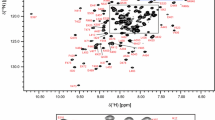Abstract
Mycobacterium tuberculosis Hsp16.3, a member of a small heat shock protein family, has chaperone-like activity in vitro and suppresses thermally or chemically induced aggregation of proteins. The nature of the interactions between Hsp16.3 and the denatured substrate proteins was investigated. A dramatic enhancement of chaperone-like activity of Hsp16.3 upon increasing temperature was accompanied by decreased ANS-detectable surface hydrophobicity. Hsp16.3 exhibited significantly enhanced chaperone-like activity after preincubation at 100°C with almost unchanged surface hydrophobicity. The interaction between Hsp16.3 and dithiothreitol-treated insulin B chains was markedly weakened in the presence of NaCl but greatly enhanced by the addition of a low-polarity alcohol, accompanied by significantly increased and decreased surface hydrophobicity, respectively. A working model for Hsp16.3 binding to its substrate proteins is proposed.
Similar content being viewed by others
REFERENCES
Morimoto, R. I., Tisscleves, A., and Georgeopovlos, C. (eds.) (1994) The Biology of Heat Shock Proteins and Molecular Chaperones, Cold Spring Harbor Laboratory, Cold Spring Harbor, New York.
Ehrnsperger, M., Buchner, J., and Gastel, M. (1998) in Molecular Chaperones in the Life Cycle of Proteins: Structure, Function and Mode of Action (Fink, A. L., and Goto, Y., eds.) Marcel Dekker, Inc., New York, pp. 533-575.
Horwitz, J. (1992) Proc. Natl. Acad. Sci. USA, 89, 10449-10453.
Merck, K. B., Groenen, P. J., Voorter, C. E., de Harrd-Hoekman, W. A., Horwitz, J., Bloemendal, H., and de Jong, W. W. (1993) J. Biol. Chem., 268, 1046-1052.
Chang, Z., Primm, T. P., Jakana, J., Lee, I. H., Serysheva, I., Chiu, W., Gilbert, H. F., and Quiocho, F. A. (1996) J. Biol. Chem., 271, 7218-7223.
Yang, H., Huang, S., Dai, H., Gong, Y., Zheng, C., and Chang, Z. (1999) Protein Sci., 8, 174-179.
Kim, K. K., Kim, R., and Kim, S. H. (1998) Nature, 394, 595-599.
Engers, H. D., Houba, V., Bennedsen, J., Buchanan, T. M., Chaparas, S. D., Kadival, G., Closs, O., David, J. R., can Embden, J. D. A., Godal, T., Mustafa, S. A., Ivanyi, J., Young, D. B., Kaufmann, S. H. E., Khomenko, A. G., Kolk, A. H. J., Kubin, M., Louis, J. A., Minden, P., Shinnick, T. M., Trnka, L., and Young, R. A. (1986) Infect. Immun., 51, 718-720.
Lee, B. Y., Hefta, S. A., and Brennan, P. J. (1992) Infect. Immun., 60, 2066-2074.
Yuan, Y., Crane, D. D., and Barry, C. E. (1996) J. Bacteriol., 178, 4484-4492.
Cunningham, A. F., and Spreadbury (1998) J. Bacteriol., 180, 801-808.
Verbon, A., Hartskeerl, R. A., Schuitema, A., Kolk, A. H. J., Young, D. B., and Lathigra, R. (1992) J. Bacteriol., 174, 1352-1359.
Yuan, Y., Crane, D. D., Simpson, R. M., Zhu, Y., Hickey, M. J., Sherman, D. R., and Barry, C. E., III. (1998) Proc. Natl. Acad. Sci. USA, 95, 9578-9583.
Das, K. P., and Surewicz, W. K. (1995) FEBS Lett., 369, 321-325.
Jones, S., and Thornton, J. M. (1996) Proc. Natl. Acad. Sci. USA, 93, 13-20.
Raman, B., and Rao, C. M. (1994) J. Biol. Chem., 269, 27264-27268.
Raman, B., Ramakrishna, T., and Rao, C. M. (1995) FEBS Lett., 365, 133-136.
Rao, C. M., Raman, B., Ramakrishna, T., Rajaraman, K., Ghosh, D., Datta, S. A., Trivedi, V. D., and Sukhaswami, M. B. (1998) Int. J. Biol. Macromol., 22, 271-281.
Datta, S. A., and Rao, C. M. (1999) J. Biol. Chem., 274, 34773-34778.
Reddy, G. B., Das, K. P., Petrash, J. M., and Surewicz, W. K. (2000) J. Biol. Chem., 275, 4565-4570.
Plater, M. L., Goode, D., and Crabbe, M. J. C. (1996) J. Biol. Chem., 271, 28558-28566.
Haslbeck, M., Walke, S., Stromer, T., Ehrnsperger, M., White, H. E., Chen, S., Saibil, H. R., and Buchner, J. (1999) EMBO J., 23, 674-675.
Author information
Authors and Affiliations
Rights and permissions
About this article
Cite this article
Mao, Q., Ke, D. & Chang, Z. Electrostatic Interactions Play a Critical Role in Mycobacterium tuberculosis Hsp16.3 Binding of Substrate Proteins. Biochemistry (Moscow) 66, 904–908 (2001). https://doi.org/10.1023/A:1011960904542
Issue Date:
DOI: https://doi.org/10.1023/A:1011960904542




